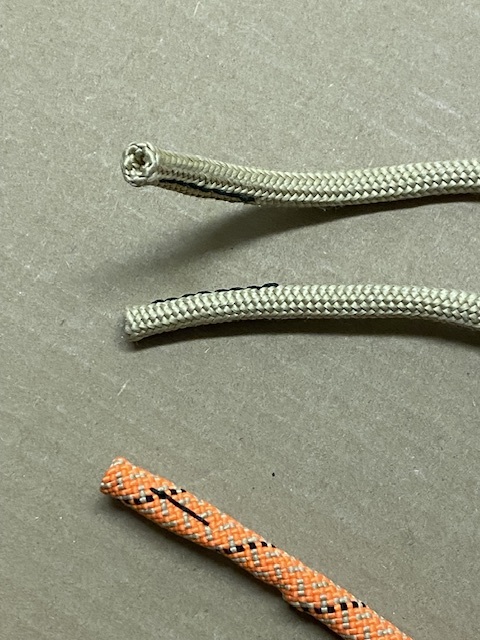I want to use some retired climbing rope for art
|
|
I want to make an art project using some retired rope, does anyone have advice on how to cut it into pieces at home without fraying? |
|
|
Wrap the part you want to cut tightly with electrical tape. Cut through the middle of the tape, so both cut ends have tape wrapped around them. Use a lighter or soldering iron to melt the end fibers together on both halfs. Pay special attention to the fibers of the mantle/sheath. |
|
|
Sparkington TheThird wrote: This is a great method, I like to use nonstretchy athletic tape to wrap before the cut, then it can easily soak sharpie ink to mark the lengths of rope. (ink wont rub off) |
|
|
For anyone who makes rope art — whether wall hangings or rugs — do you attach the rope pieces to some kind of under layer? By what method? I’ve been curious about this for a while, but haven’t actually given it a try. |
|
|
If you have a lot of cuts to make... Dremel type rotary tool with a large cut-off disk, running at >15k RPM. Tape the spot you want to cut, tightly, with masking tape -- and then as the disk cuts, it instantly melts the fibers with friction heating. Pull the tape off, and you get a perfect, clean cut every time. If you want a more durable end, flame the cut ends for a few seconds to let them melt deeper. I like to clamp the Dremel to a bench/table, and hold the rope pieces in my hands. I also use work gloves & safety glasses, anytime the Dremel gets switched on. When it's worth the time, I sometimes use CA glue rather than just heat to fuse the ends: • Coat a ~1" section of rope, all the way around, with any kind of CA glue -- Gorilla, Super, Krazy, and LocTite all work. • Wrap the glued 1" section *tight* with self-sealing silicone tape. This forces the glue to soak onto the sheath fibers, and CA glue doesn't adhere to silicone tape. • Let it dry for an hour (maybe more in dry climates), and then cut it in the middle of the tape with the Dremel method, and remove the tape. CA glued ends are more durable than melted ends, and they get nicely tapered by constriction of the tape. If you want even more durability -- heat shrink tubing over the ends. Comes in all sorts of fun colors, and marine-grade tubing is also lined with a hot-melt adhesive that cements really well onto nylon & dyneema, with or without CA glue... I use the same colors on my rope ends as I do for the nail polish dots on my carabiners. |
|
|
beck will wrote: I used cardboard layering for my backdrop piece then glued the rope to it |
|
|
After years of trimming ropes with tape and a lighter I finally got one of these. I feel like it would be essential for cutting ropes neatly for art projects. Incidentally, if you need retired ropes in Central Oregon I periodically have old ones to give away |
|
|
Torch a (butter) knife over a gas burner or torch and see how it works. |
|
|
Kevin Piarulli wrote: Actually that would be rad, message me? |
|
|
|
|
|
Tape and cut, ceramic knives are nice, take some of the core out, and pull the cover inside itself to get a finished end. Some pieces of wooden dowel could be used to keep two ends together. |
|
|
Mehgnn Bentley wrote: A bit overkill for nylon ropes: https://rali-shop.com/rali-cut.html The rope sits in the slots, and cuts very cleanly without burning nor melting. Very clean cut. I used it for this type of cord: https://sterlingrope.com/6-mm-xtec/ Then finished the ends with JB Weld Epoxy. |
|
|
Li Hu wrote: I have to try that epoxy finish, sometime... Bet that's durable as hell. It's been tricky to find something that works well for the long haul -- gym ropes especially, when I'm able to climb nearly everyday. Thanks for the idea. |

 Continue with onX Maps
Continue with onX Maps Sign in with Facebook
Sign in with Facebook





















